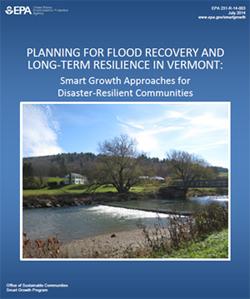Smart Growth Approaches for Disaster-Resilient Communities

Flooding from storms affects many communities across the country, causing billions of dollars of damage annually. Climate change projections suggest that storms will likely become more frequent and stronger in many regions of the country in the future. In light of these trends, many communities want to improve disaster recovery and long-term flood resilience planning. “Flood resilience” means measures taken to reduce communities' vulnerability to flooding and support long-term recovery after a flood.
Communities throughout Vermont faced this reality when Tropical Storm Irene hit in 2011, devastating infrastructure, communities, and lives. In 2012, in the wake of Irene, the state of Vermont requested Smart Growth Implementation Assistance from EPA and the Federal Emergency Management Agency (FEMA). The assistance focused on incorporating smart growth principles into state policies, local development regulations, and Hazard Mitigation Plans to increase community flood resilience.
Planning for Flood Recovery and Long-Term Resilience in Vermont (2014) includes:
- Overall strategies for flood resilience and disaster recovery.
- Local land use policy options and strategies to improve flood resilience.
- State policy options and strategies to improve flood resilience.
Learn more:
- The Flood Resilience Checklist can help communities determine whether their policies prepare them for floods.
- Read and listen to "Mad River Towns Are Models For National Flood Planning," Exit a July 8, 2014, report about the project on Vermont Public Radio.
- Visit our Smart Growth Strategies for Disaster Resilience and Recovery page for more resources.
